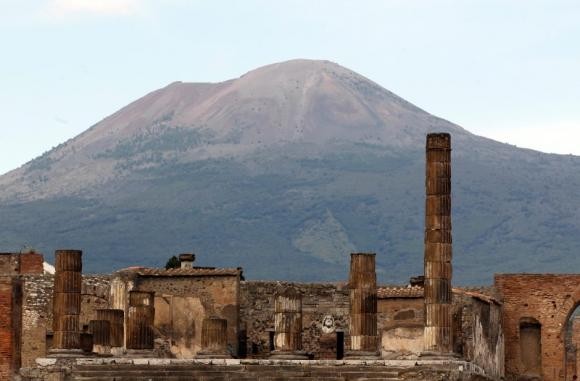Scientists Decipher Ancient Papyrus Texts Buried by Volcano
| Marco Foronda | | Jan 21, 2015 07:44 AM EST |
(Photo : REUTERS/CIRO DE LUCA) A partial view of the ancient archaeological site of Pompeii.
It's now possible to read hundreds of ancient papyrus scrolls buried nearly 2,000 years ago by the eruption of Mount Vesuvius.
The new technique uses X-ray phase-contrast tomography. It deciphers the charred, damaged texts of scrolls discovered in an ancient town of Herculaneum without having to unroll them, experts say. Herculaneum and Pompeii were among several Roman towns destroyed when Mount Vesuvius erupted in 79 A.D.
Like Us on Facebook
Experts say the letters on the papyrus are slightly raised in height and X-rays waves that hit the letters are reflected back with a slightly shifted phase compared to the waves that hit the underlying material. By measuring this phase difference, the team was able to reproduce the shape of the letters inside the rolled scrolls.
Some of the texts from what is called the Villa of the Papyri have been deciphered since the 1750s when they were discovered. But many more remain a mystery to science because they were so badly damaged that unrolling the papyrus they were written on would have destroyed them completely.
"The papyri were completely covered in blazing-hot volcanic material," said Vito Mocella, a theoretical scientist at the Institute of Microelectronics and Microsystems in Naples who led the latest project.
One problem with previous attempts to use X-rays to read the scrolls was that the ancient writers used a carbon-based material in their ink.
The researchers said that if the new technique works, it could be used to disclose the secrets of one of the few intact libraries from antiquity.
So far, the team has analyzed six scrolls given to Napoleon Bonaparte as gifts and that are now housed at the French Institute in Paris. They've deciphered some of the Greek letters and words written inside the rolled-up, burned, smashed scrolls.
The most challenging part for researchers is deciphering the words in the innermost layers of the ancient scrolls.
Details of the new technique were explained in the journal, Nature Communications.
TagsMount Vesuvius, ancient papyrus scroll, scrolls, Eruption of Mount Vesuvius in 79, volcanoes, X-ray phase-contrast tomography, Pompeii
©2015 Chinatopix All rights reserved. Do not reproduce without permission
EDITOR'S PICKS
-

Did the Trump administration just announce plans for a trade war with ‘hostile’ China and Russia?
-

US Senate passes Taiwan travel bill slammed by China
-

As Yan Sihong’s family grieves, here are other Chinese students who went missing abroad. Some have never been found
-

Beijing blasts Western critics who ‘smear China’ with the term sharp power
-

China Envoy Seeks to Defuse Tensions With U.S. as a Trade War Brews
-

Singapore's Deputy PM Provides Bitcoin Vote of Confidence Amid China's Blanket Bans
-

China warns investors over risks in overseas virtual currency trading
-

Chinese government most trustworthy: survey
-

Kashima Antlers On Course For Back-To-Back Titles
MOST POPULAR
LATEST NEWS
Zhou Yongkang: China's Former Security Chief Sentenced to Life in Prison

China's former Chief of the Ministry of Public Security, Zhou Yongkang, has been given a life sentence after he was found guilty of abusing his office, bribery and deliberately ... Full Article
TRENDING STORY

China Pork Prices Expected to Stabilize As The Supplies Recover

Elephone P9000 Smartphone is now on Sale on Amazon India

There's a Big Chance Cliffhangers Won't Still Be Resolved When Grey's Anatomy Season 13 Returns

Supreme Court Ruled on Samsung vs Apple Dispute for Patent Infringement

Microsoft Surface Pro 5 Rumors and Release Date: What is the Latest?










